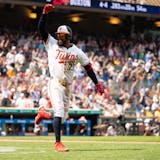George Growingthunder looked at the ancient rock carvings and wept as the sun rose over Jeffers Petroglyphs, a historical site in southwestern Minnesota. He was thankful to visit the land of his ancestors, and he was gratified the Minnesota Historical Society was working to do a better job telling this site's history from Native Americans' point of view — a perspective absent in many museums and historical sites around the country.
Soon, Growingthunder hopes to bring that perspective to his career. A student at the Institute of American Indian Arts in Santa Fe, N.M., Growingthunder was one of six students from around the nation who joined a summer historical society program aimed at including more Native voices in the telling of history. He studied efforts to decolonize museums, learned about repatriation of objects in museum collections and helped build exhibits.
"I'm a changed person," he said. "(The Minnesota Historical Society) is a template. They're changing the narrative, treating us like people instead of a collection object. They've done something a lot of other museums don't do."
The Native American Undergraduate Museum Fellowship has been part of the Minnesota Historical Society for more than a decade and is nearing 100 alums. A 2019 grant from the Mellon Foundation helped expand it to a 10-week program. Many alums work in the museum field. Six have gone on to get their Ph.D.
The fellows traveled to historical sites around Mni Sota Makoce — Dakota for "the land where the waters reflect the clouds" and the inspiration for the name Minnesota — while interning in their chosen discipline. Some compiled digital databases of the museum's collection of documents and artifacts from their tribes. Others digitized tribal newspapers or worked in research. Growingthunder worked in exhibit design.
"A lot of times these students say they never saw museums as a place for them, never thought they belonged," said Amber Annis, director of Native American Initiatives at the Minnesota Historical Society and a citizen of the Cheyenne River Sioux tribe. "There's a responsibility that museums have, that the history field has — fields that have taken advantage of Native communities. And there's no one better to tell our own stories, understand our history, than Native people themselves."
The field is shifting slowly, Annis said, to center Native voices. But the Minnesota Historical Society remains the rare state historical museum with a department dedicated to Native nations and communities.
Gavin Zempel is from the Lower Sioux Indian Community in southwest Minnesota and a is senior at the University of Minnesota Morris. He's been studying the Pipestone Indian Training School — one of many boarding schools in the late 1800s and early 1900s that aimed to assimilate Indian youth into mainstream American culture — and its effects on Dakota people, including his own family.


